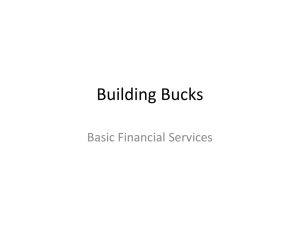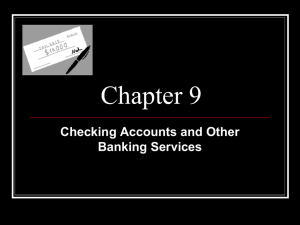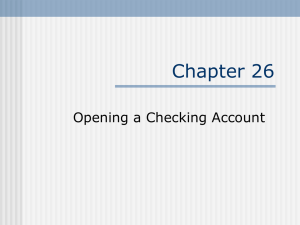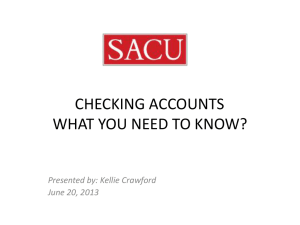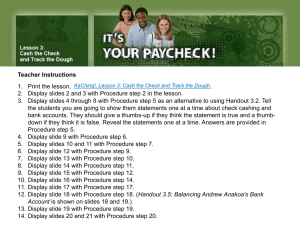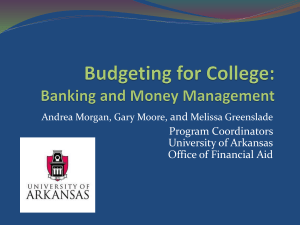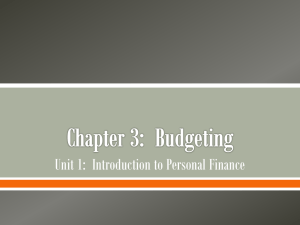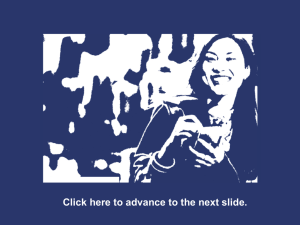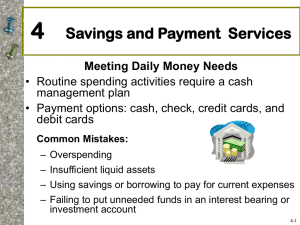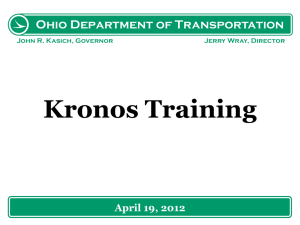Chapter 9 Notes
advertisement
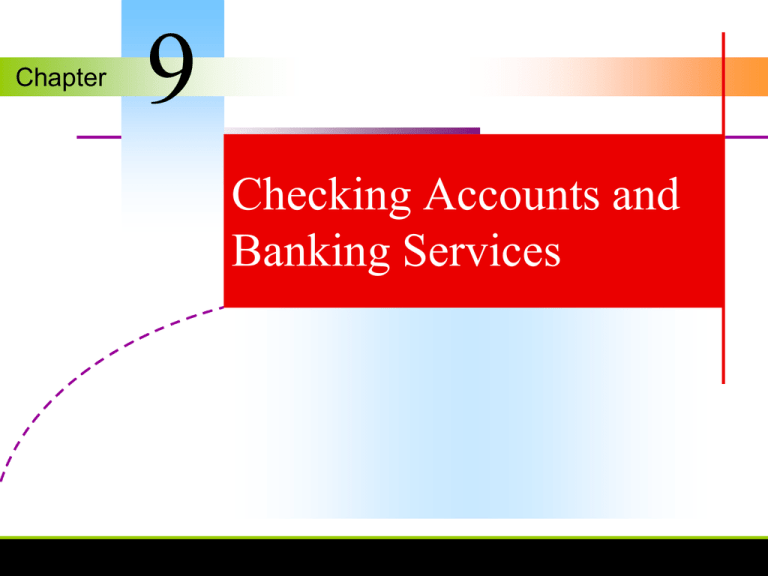
Chapter 9 Checking Accounts and Banking Services Checking Accounts GOALS Describe the purpose of a checking account and the forms associated with it. Explain how to use a checking account. Discuss the types of checking accounts. Chapter 9 SLIDE 2 Checking Account Basics A checking account allows you to write checks to make payments. A check is a written order to a bank to pay the amount stated to the person or business named on it. A checking account is also called a demand deposit, because the money may be withdrawn at any time—that is, “on demand.” Chapter 9 SLIDE 3 (continued) Checking Account Basics Checks follow a process through the banking system. The payee cashes your check. The bank that cashed the check returns it to your bank. Your bank withdraws the money from your account and sends it to the other bank. Your bank then stamps the back of your check, indicating that it has cleared. A canceled check is a check that has cleared your account. Chapter 9 SLIDE 4 (continued) Checking Account Basics Many banks no longer send paper checks to other banks for processing. To make processing faster and more efficient, they exchange check information electronically by transmitting an image of the check, called a substitute check. A substitute check can be used in the same way as an original check. Chapter 9 SLIDE 5 (continued) Checking Account Basics You must also maintain enough money in your account to cover all the checks you write. A check written for more money than your account contains is called an overdraft. A bank that does not honor a check usually stamps the check with the words “not sufficient funds” (NSF) and returns the check to the payee’s bank. When this occurs, the check has bounced. Your bank will charge you a fee for each NSF check processed. Chapter 9 SLIDE 6 (continued) Checking Account Basics Floating a check is writing a check and hoping to deposit money to cover it before the check clears. Floating a check is very risky because today’s electronic systems allow checks to process very quickly. Floating a check is illegal in most states. Chapter 9 SLIDE 7 Checking Account Advantages Convenience Safety Built-in record keeping system Access to bank services Chapter 9 SLIDE 8 Opening a Checking Account Signature authorization form Initial deposit Chapter 9 SLIDE 9 Parts of a Check Check Number Name and Address of Maker Date Payee ABA Number Numeric Amount Written Amount Memo Signature Account and Routing Numbers Chapter 9 SLIDE 10 Using Your Checking Account Writing checks Paying bills online Making deposits Using a checkbook register A checkbook register is a booklet used to record checking account transactions. Chapter 9 SLIDE 11 Bank Reconciliation The process of matching your checkbook register with the bank statement is known as bank reconciliation. Chapter 9 SLIDE 12 Reconciling Your Checking Account 1. Write ending balance from bank statement. 2. Add credits or deposits not on statement. 3. Total lines 1 and 2. 4. List checks, withdrawals, and debits made but not shown on statement. 5. Total outstanding checks/debit transactions. 6. Subtract line 5 from line 3. (Result should match checkbook balance) Chapter 9 SLIDE 13 Endorsing Checks A check generally cannot be cashed until it is endorsed. To endorse a check, the payee signs the top part of the back of the check in ink. There are three major types of endorsements. Blank endorsement Special endorsement Restrictive endorsement Chapter 9 SLIDE 14 Blank Endorsement A blank endorsement is the signature of the payee written exactly as his or her name appears on the front of the check. Chapter 9 SLIDE 15 Special Endorsement A special endorsement, or an endorsement in full, is an endorsement that transfers the right to cash the check to someone else. Chapter 9 SLIDE 16 Restrictive Endorsement A restrictive endorsement restricts or limits the use of a check. Chapter 9 SLIDE 17 Types of Checking Accounts Free checking Individual account Joint accounts Interest-bearing accounts Chapter 9 SLIDE 18 Banking Services A full-service bank is one that offers every possible kind of service, from savings and checking accounts to credit cards, safe deposit boxes, loans, and ATMs. Other services commonly offered are online banking, telephone banking, certified checks, cashier’s checks, money orders, and debit cards. Most banks offer FDIC (Federal Deposit Insurance Corporation) insurance, which protects the deposits of customers against loss up to $250,000 per account. Chapter 9 SLIDE 19 Guaranteed-payment Checks A certified check is a personal check that the bank guarantees or certifies to be good. A cashier’s check, also called a bank draft, is a check written by a bank on its own funds. Chapter 9 SLIDE 20 Money Orders Banks sell money orders to people who do not wish to use cash or do not have a checking account. A money order is like a check, except that it can never bounce. There is a charge for purchasing a money order. You also can purchase money orders through the post office and local merchants. Chapter 9 SLIDE 21 Debit Cards A debit card is a plastic card that deducts money from a checking account almost immediately to pay for purchases. The debit card is presented at the time of purchase. When a debit card is used, the amount of the purchase is quickly deducted from the customer’s checking account and paid to the merchant. Chapter 9 SLIDE 22 Safe Deposit Boxes Financial institutions offer customers a safe deposit box to store valuable items or documents. They charge a yearly fee based on the size of the box. Keeping important documents and other items in a safe deposit box ensures that the items won’t be stolen, lost, or destroyed. Chapter 9 SLIDE 23 (continued) Safe Deposit Boxes Examples of items commonly kept in a safe deposit box include Birth, marriage, and death certificates Deeds and mortgage papers Stocks and bonds Jewelry Coin collections Chapter 9 SLIDE 24 Loans and Trusts Financial institutions also make loans to finance the purchase of cars, homes, home improvements, vacations, and other items. Banks can also provide advice for estate planning and trusts. Banks can act as trustees of estates for minors and others. A trustee is a person or an institution that manages property for the benefit of someone else under a special agreement. Chapter 9 SLIDE 25 Bank Credit Cards You can apply to a full-service bank for a bank credit card, such as a Visa or MasterCard. If you meet the requirements and are issued a card, you can use it instead of cash at any business that accepts credit cards. Banks offering national credit cards usually charge both an annual fee for use of the card and interest on the unpaid account balance. Chapter 9 SLIDE 26 Automated Teller Machines An Automated Teller Machine is often called an ATM. To use ATMs, you must Have a card that is electronically coded Know your personal identification number (PIN) Getting cash is a common ATM transaction. Using a debit card you can withdraw cash from your checking or savings account. Using a Visa or MasterCard, you can receive a cash advance electronically. Chapter 9 SLIDE 27 Stop Payment Orders A stop-payment order is a request that the bank not honor a specific check. The usual reason for stopping payment is that the check has been lost or stolen. Most banks charge a fee for stopping payment on a check. Chapter 9 SLIDE 28 Overdraft Protection Overdraft protection allows you to cover checks or withdrawals up to a specified amount, usually between $100 and $1,000, depending on the typical balance in your account. With overdraft protection, your checks will be covered even if you have insufficient funds in your checking account. Chapter 9 SLIDE 29 Online and Telephone Banking Online and telephone banking services give you the ability to access your accounts from a computer or telephone anytime, day or night. Services include: Transferring money from one account to another Paying bills by authorizing the bank to disburse money Getting account balances Seeing which checks have cleared and which deposits have been entered Chapter 9 SLIDE 30 (continued) Online and Telephone Banking Most banks also allow and encourage electronic transfers of money. An electronic funds transfer (EFT) uses a computer-based system that enables you to move money from one account to another without writing a check or exchanging cash. Chapter 9 SLIDE 31 Notary Public A notary public verifies a person’s identity, witnesses the person’s signature on a legal document, and then “notarizes” the signature as valid. Financial institutions typically have a person on their staff who is a notary public. This person provides notary services for account holders, usually without charge. For noncustomers, however, there is typically a small fee. Chapter 9 SLIDE 32 Financial Services Purchasing or selling savings bonds Investment brokerage services Chapter 9 SLIDE 33 Bank Fees Banks charge fees to their customers to help cover their operating costs. The best way to avoid fees is to choose the right kind of account. Shop around and find the account that is right for you. Be aware of the rules of your account, so that you don’t violate them and be required to pay high fees. Chapter 9 SLIDE 34 Examples of Bank Fees Loan fees Trustee fees Check cashing fees Per-check fees Monthly service fees Overdraft fees NSF check charges ATM transaction fees Safe deposit box fees Teller service fees Minimum balance fees Fees for guaranteedpayment checks Notary service fees Online bill payment fees Fees to return canceled checks Chapter 9 SLIDE 35
